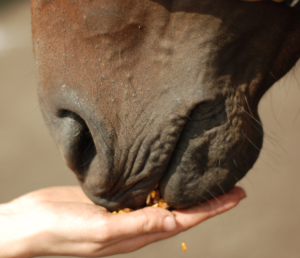Six Ways to Slow Horse Feed Intake

There has been a recent trend to manage horses in a more “natural” manner, especially when it comes to feeding. Extending the length of time horses spend foraging has been linked to improvements in horse health and wellbeing, including reductions in unwanted behaviors, ulcers, choke and insulin and glucose responses after a meal. Slowing feed intake is also important for horses on restricted diets, those who are meal fed a few times each day, and horses who tend to aggressively and quickly feed. Many horse owners can slow equine feed intake rates by simply altering how they deliver feed to their horse.
1. Slow”feed Hay Nets
Researchers from the University of Minnesota recently evaluated different hay nets to determine the effect on horse intake rates. Horses were fed hay (1% bodyweight twice daily) off the boxstall floor (control), or from one of three hay nets, including a large net (6 inch openings), medium net (1.75 inches) and small net (1.0 inch). The study revealed that horses feeding from the medium net took just over 5 hours to consume the hay meal, while horses eating from the small nets took 6.5 hours to consume the meal. Both the control and large net resulted in consumption times of 3.2 and 3.4 hours, respectively. If small or medium hay nets (Hay Chix hay nets) were used for twice daily feedings, the anticipated amount of time horses would spend foraging would be 10 to 13 hours each day, more closely mimicking a horse’s natural grazing behavior.
2. Grazing Muzzles
Recent research has shown that grazing muzzles can help slow horse intake of both pasture and grain. Researchers from the University of Minnesota determined the use of a grazing muzzle (Weaver) reduced a horse’s pasture intake by approximately 30%. Researchers from Illinois recently evaluated two grazing muzzles (Tough 1 Nylon and Easy Breathe) when horses were fed grain and determined that the use of a grazing muzzle slowed grain intake but tended to spill more grain. However, horses were able to acclimate to the grazing muzzle and increased their intake rate over time.
3. Specialized Grain Feeders
Researchers from Texas A&M University tested a newly designed feed bucket (Pre”Vent Feeder) and determined that the bucket slowed grain consumption and reduced grain spillage. Horses spent 21 to 60 additional minutes eating grain from the feeder compared to a bucket or tub. In some situations, regular cleaning of the feeder will be needed. In a separate study, researchers from North Carolina State University developed a waffle structure that was inserted into a feed bucket. They concluded the waffle insert increased grain consumption time by nearly 50% compared to a bucket without the waffle insert.
4. Obstacles
Researchers from North Carolina State University tested grain feeding time using a bucket with four movable boccestyle balls (4 inch diameter) placed in it and found the balls were effective at extending (by 4 minutes) and maintaining the time it took horses to consume feed after multiple days of use. Additionally, the researchers found that the balls produced the lowest glucose and insulin responses compared to other feeding methods tested.
5. Forage Quality
The fiber content in hays can be used to slow horse consumption. Neutral detergent fiber (NDF) is a measurement of insoluble fiber and provides the plant with structural rigidity. The higher the NDF, the less a horse will consume. NDF levels between 40 and 50% are considered ideal and promote hay intake, while NDF levels above 65% tend to result in a reduction in intake by most horses. Hays high in NDF tend to be classified as “busy hay” and are especially useful when managing aggressive and quick eaters or horses on a restricted diet. However, only a small proportion of a horse’s diet should be comprised of “busy hay” high in NDF.
6. Feeding Order
Many people believe that feeding hay before grain slows feed intake. Research has confirmed this belief and determined that horses consumed grain slower when hay was fed 20 minutes before the grain meal. When hay was fed before grain, grain consumption was 0.3 pounds per minute compared to 0.4 pounds per minute when hay and grain were fed simultaneously.
Slow”feed hay nets, grazing muzzles, specialized grain feeders, obstacles, forages high in NDF and feeding order are all effective management strategies for slowing horse feed intake and represent simple and affordable management options horse owners can implement.
This article is reprinted with permission from Krishona Martinson, University of Minnesota. This and other horse nutrition articles can be found at http://www.extension.umn.edu/agriculture/horse/nutrition/.
